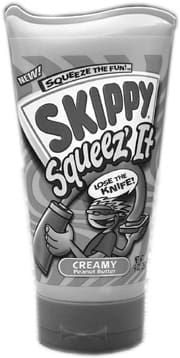by CJ Puotinen
What could be more convenient? Many trainers are recommending Skippy’s “Squeez’ It” as a convenient training tool because it can be used to dispense a peanut butter treat right into the mouth of a dog who deserves a reward. The dog loves it, and his handler’s hands stay clean and dry. No wonder this product is getting rave reviews from trainers.
But wait a second. What’s in that blue plastic squeeze tube? Roasted peanuts are the first ingredient, followed by sugar, salt, and partially hydrogenated rapeseed, cottonseed, and soybean oils.
“Forget it,” says holistic veterinarian Stacey Joy Hershman of Nyack, New York. “Peanuts are covered with pesticides unless they’re organically grown, which these peanuts are not. And dogs simply aren’t meant to eat sugary, salty foods, which can predispose them to tooth and gum disease, diabetes, gastrointestinal upsets like vomiting and diarrhea, and liver and kidney problems. In addition, peanut butter is fattening and shouldn’t be given to overweight dogs. It also shouldn’t be given to those prone to diarrhea, since peanut butter can act as a laxative.”
If peanut butter does agree with your dog’s digestive tract, only an organic product should be used. Peanuts are among America’s most chemically treated crops.
Sugar is a serious problem in any pet food. Some holistic veterinarians blame grains, sugar, and other carbohydrates for the epidemic of obesity and diabetes in America’s dogs. Sugar makes up nearly 10 percent of Skippy’s Squeez’ It.
What about salt? This product contains 160 milligrams of salt per serving. Dogs do need sodium, but there are better sources than refined table salt, which has been stripped of its trace elements, bleached, and treated with chemicals.
Avoid “partially hydrogenated” anything
Vegetable oils have always been problem ingredients for food processors. Because unsaturated and polyunsaturated vegetable oils are unstable and quickly go rancid, they are often refined, a process that strips them of nutrients while giving them a longer shelf life. Because they remain liquid at room temperature, these oils are often “hydrogenated,” a plasticizing process that makes them solid, like margarine.
Hydrogenated vegetable oils are popular with food processors because they reduce cost, extend the storage life of products, and can improve flavor and texture. Unfortunately, hydrogenation creates trans fatty acids, or trans fats, which are similar but not identical to natural fats.
Because of their links to heart disease and type 2 or adult-onset diabetes, trans fats have – finally – caught the attention of the U.S. Food and Drug Administration (FDA), which recently announced that beginning in 2006, food manufacturers will be required to list trans fats on their products’ labels. In the meantime, consumers fending for themselves can read ingredient lists and avoid products that contain hydrogenated or partially hydrogenated vegetable oils.
While there have not been studies about the effects of trans fats on dogs, the wealth of information about their deleterious effects on humans – and common sense – suggest they should be avoided. “The hydrogenated fats in Skippy peanut butter concern me more than anything else in this product,” agrees clinical nutritionist Krispin Sullivan of Woodacre, California.
Go natural – and organic
Peanut butter is very fattening; a tablespoon contains about 100 calories. A motivated dog with a generous trainer can quickly consume a lot of calories. But unless your dog is very overweight a few pea-sized dabs of natural peanut butter isn’t likely to do lasting damage, and it does contain protein, fat, niacin pantothenic acid, biotin, other B vitamins, vitamin E, iron, calcium, potassium, and tryptophan, an amino acid that benefits the nervous system.
To take advantage of the nutritional benefits of peanuts without subjecting your dog to the detrimental ingredients in most commercial peanut butters, look for peanut butter made from organically raised peanuts and salted with unrefined sea salt. Most health food stores carry several brands, and many grind their own. You can grind your own, too, with the help of a food processor.
“Using plain peanut butter that doesn’t contain additives or grinding your own avoids the problems that added vegetable oils create,” says Sullivan.
As for that handy blue dispenser, it’s easy to replace the contents of Skippy Squeez’ It tubes with better peanut butter. For easy refilling, use room-temperature or slightly warmed creamy (rather than chunky) organic peanut butter, screw the flip-top lid back on, and give that dog a little treat.






